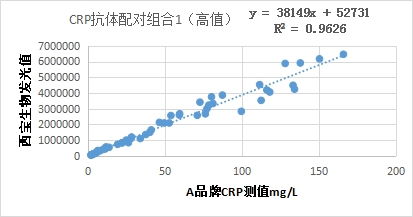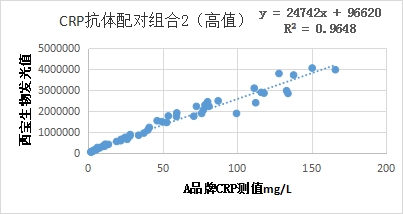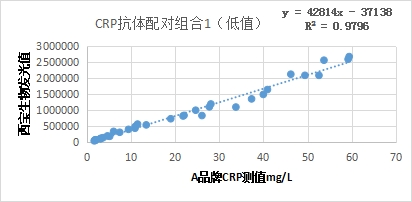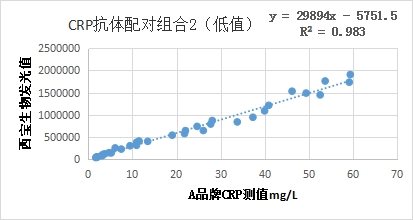C-Reactive Protein (CRP) - Magnetic Particle Chemiluminescent (Acridinium Ester) Solution
Time:2024-01-24 Hits:249
1. Project Background
"Guiding Principles for Technical Review of Registration of C-Reactive Protein Assay Kits"
C-reactive protein (CRP) is synthesized by liver cells, produced during the fetal period, and transmitted non-maternally through the placenta. Its production mechanism is as follows: when the body is infected or tissue is damaged, activated macrophages and other white blood cells produce cytokines such as interleukin-6 (IL-6), interleukin-1 (IL-1), and tumor necrosis factor (TNF-a). These mediators reach the liver and stimulate hepatocytes and epithelial cells to synthesize CRP. Structurally, CRP contains 5 polypeptide chain subunits, non-covalently combined into a disc-shaped polymer with a molecular weight of 115,000-140,000. CRP is a typical acute phase protein, including conventional C-reactive protein (conventional CRP) and high-sensitivity C-reactive protein (hypersensitive CRP). Detecting both types at once is called a full C-reactive protein test. There is no chemical difference between conventional CRP and high-sensitivity CRP; they are the same substance, but the quantitative lower limit of the detection method differs.
Routine CRP measurement includes qualitative, semi-quantitative, and quantitative analysis and is used to evaluate infection, tissue damage, and inflammatory diseases. The reference value for routine CRP determination is typically considered clinically significant above 10 mg/L. CRP levels in the blood of healthy individuals are below 5 mg/L. In various conditions, within 4-8 hours of acute inflammation, CRP values reach approximately 20 to 500 mg/L. Conventional CRP is more sensitive and reliable than erythrocyte sedimentation rate (ESR) and white blood cell count as an acute inflammation assessment indicator.
The low end of the linear range of high-sensitivity C-reactive protein is lower than conventional CRP, expanding its indications for use. C-reactive protein is non-specific and must be comprehensively evaluated in conjunction with clinical symptoms. It cannot be used as a specific disease or risk of disease basis for diagnosis.
A common use of high-sensitivity C-reactive protein is as an aid in cardiovascular disease risk identification. When used with traditional clinical diagnosis of acute coronary syndrome, it serves as an early warning indicator for the recurrence of coronary artery disease or acute coronary syndrome.
2. Performance
2.1 Chemiluminescence (Acridinium Ester) Platform:
2.1.1 Combination 1:
Human C-reactive protein (CRP) monoclonal antibody AP (Cat. No.: EKY0128AP) coated carboxyl magnetic beads +
Human C-reactive protein (CRP) monoclonal antibody AQ (Cat. No.: EKY0128AQ) labeled acridinium ester;
Linear range: 0.5 mg/L-200 mg/L;
Stability of the reagent under thermal acceleration at 37°C for 7 days: the luminescence value changes around ±15%;
Human C-reactive protein (CRP) monoclonal antibody AQ (Cat. No.: EKY0128AQ) labeled acridinium ester;
Linear range: 0.5 mg/L-200 mg/L;
Stability of the reagent under thermal acceleration at 37°C for 7 days: the luminescence value changes around ±15%;
2.1.2 Combination 2:
Human C-reactive protein (CRP) monoclonal antibody AQ (Cat. No.: EKY0128AQ) coated carboxyl magnetic beads +
Human C-reactive protein (CRP) monoclonal antibody AP (Cat. No.: EKY0128AP) labeled acridinium ester;
Linear range: 0.5 mg/L-200 mg/L;
Stability of the reagent under thermal acceleration at 37°C for 7 days: the luminescence value changes around ±10%;
Human C-reactive protein (CRP) monoclonal antibody AP (Cat. No.: EKY0128AP) labeled acridinium ester;
Linear range: 0.5 mg/L-200 mg/L;
Stability of the reagent under thermal acceleration at 37°C for 7 days: the luminescence value changes around ±10%;
3. Clinical Relevance
Chemiluminescence (Acridinium Ester) Platform:
Clinical correlation with brand A CRP reagent R² > 0.95;
Correlation between the low-value part (≤60 mg/L) and brand A CRP reagent R² > 0.95.
Correlation between the low-value part (≤60 mg/L) and brand A CRP reagent R² > 0.95.




4. Test Plan
Antigen to be tested: C-reactive protein (CRP), sample/standard: pre-diluted 200 times, adding volume 10 ul;
Reagent 1: CRP EKY0128AP/AQ monoclonal antibody-magnetic bead dilution, dosage 50 ul/test;
Reagent 2: CRP EKY0128AQ/AP monoclonal antibody-acridinate dilution, dosage 50 ul/test;
Reaction conditions: incubation temperature 37°C, sample + reagent 1 + reagent 2 (6 min-10 min);
Luminescence instrument used in the test: Cosmai SMART 500S; chemiluminescence instrument applicable to various acridinium ester systems (such as Sichuan Mike, Shenzhen Yahuilong, Shandong Kanghua Bio, Getein Bio, Nanjing Norman, etc.).
Reagent 1: CRP EKY0128AP/AQ monoclonal antibody-magnetic bead dilution, dosage 50 ul/test;
Reagent 2: CRP EKY0128AQ/AP monoclonal antibody-acridinate dilution, dosage 50 ul/test;
Reaction conditions: incubation temperature 37°C, sample + reagent 1 + reagent 2 (6 min-10 min);
Luminescence instrument used in the test: Cosmai SMART 500S; chemiluminescence instrument applicable to various acridinium ester systems (such as Sichuan Mike, Shenzhen Yahuilong, Shandong Kanghua Bio, Getein Bio, Nanjing Norman, etc.).
5. Product Information (Large packaging reagents available)
|
Product
|
Item number
|
Recommended pairing
|
|
Human C-reactive protein (CRP) monoclonal antibody AP
|
Human C-reactive protein (CRP) monoclonal antibody AP (Cat. No.: EKY0128AP) coated carboxyl magnetic beads + human C-reactive protein (CRP) monoclonal antibody AQ (Cat. No.: EKY0128AQ) labeled acridinium ester (combination1)
|
|
|
Human C-reactive protein (CRP) monoclonal antibody AQ
|
Human C-reactive protein (CRP) monoclonal antibody AQ (Cat. No.: EKY0128AQ) coated carboxyl magnetic beads + human C-reactive protein (CRP) monoclonal antibody AP (Cat. No.: EKY0128AP) labeled acridinium ester (combination2)
|
|
|
Human C-reactive protein (CRP)
|
EKY0133B
|
|
|
Human C-reactive protein (CRP) monoclonal antibody AP-carboxy magnetic beads concentrate
|
DKY1305A
|
|
|
Human C-reactive protein (CRP) monoclonal antibody AQ-carboxy magnetic beads concentrate
|
DKY1305B
|
|
|
Human C-reactive protein (CRP) monoclonal antibody AP-acridinate concentrate
|
DKY1305C
|
|
|
Human C-reactive protein (CRP) monoclonal antibody AQ-acridinate concentrate
|
DKY1305D
|
|
|
Human C-reactive protein antigen diluent
|
DKY1306A
|
|
|
Human C-reactive protein (CRP) monoclonal antibody-carboxy magnetic beads concentrate diluent
|
DKY1307A
|
|
|
Human C-reactive protein (CRP) monoclonal antibody-acridinate concentrate diluent
|
DKY1308A
|
|
|
Carboxy magnetic beads (superparamagnetic), 1um
|
DEG0091B-1
|
|
|
Carboxy magnetic beads (superparamagnetic), 3um
|
DEG0091A-3
|
|
For more product details, please contact us: service@seebio.cn or Phone: +86 21 58183719 or Wechat: +86 158 0195 7578
